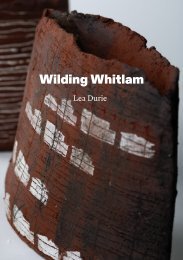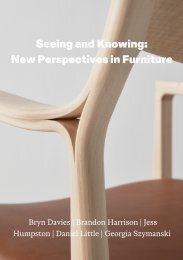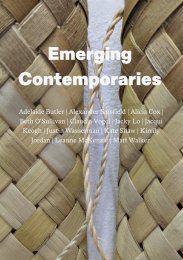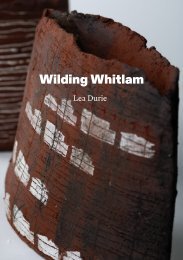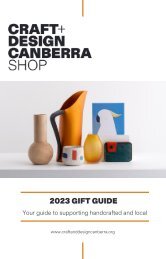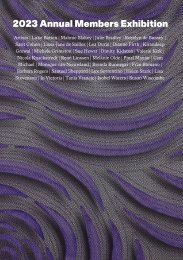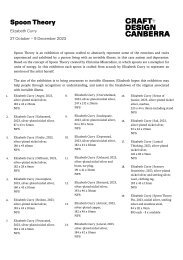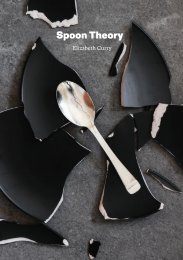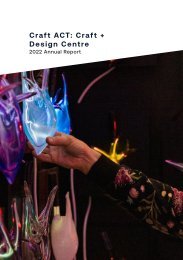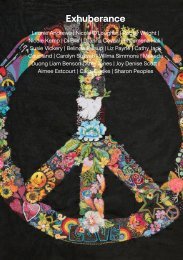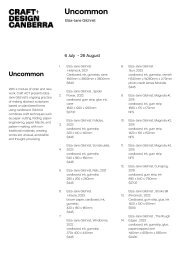Craft ACT Artist-in-residence 2014: Bogs and Fens
Sally Blake, Annee Miron and Satoshi Fujinama
Sally Blake, Annee Miron and Satoshi Fujinama
- No tags were found...
Create successful ePaper yourself
Turn your PDF publications into a flip-book with our unique Google optimized e-Paper software.
<strong>Bogs</strong> <strong>and</strong> <strong>Fens</strong>: a rtist-<strong>in</strong>-<strong>residence</strong><br />
<strong>and</strong> modern suffer<strong>in</strong>g, of fragility <strong>and</strong><br />
<strong>in</strong>terconnectedness articulated through<br />
sp<strong>in</strong>dl<strong>in</strong>g cardboard, <strong>and</strong> the robust<br />
life‐giv<strong>in</strong>g mechanisms presented <strong>in</strong> the<br />
form of seed-pods thick with colour.<br />
Miron, Blake <strong>and</strong> Fuj<strong>in</strong>uma have formed<br />
their own illustrative ecosystems of<br />
mean<strong>in</strong>g that connect, strengthen,<br />
<strong>and</strong> <strong>in</strong>terplay with one another on the<br />
exhibition floor. They have given us a<br />
modern dictionary from which to graft<br />
our own underst<strong>and</strong><strong>in</strong>g of bogs <strong>and</strong> fens.<br />
Moreover, their work rem<strong>in</strong>ds us that<br />
def<strong>in</strong>itions are, by nature (<strong>and</strong> <strong>in</strong> nature),<br />
multiplicit. Each piece celebrates the<br />
diversity of human that is welcomed by<br />
country: to relate to <strong>and</strong> <strong>in</strong>terpret it, so<br />
long as that environment or l<strong>and</strong>scape<br />
rema<strong>in</strong>s the creative message or priority.<br />
It is through this lens of environmental<br />
underst<strong>and</strong><strong>in</strong>g that artist-<strong>in</strong>-<strong>residence</strong><br />
Sally Blake cont<strong>in</strong>ually looks to,<br />
‘develop a deeper underst<strong>and</strong><strong>in</strong>g of<br />
the <strong>in</strong>terconnections between nature’s<br />
pattern <strong>and</strong> processes, <strong>and</strong> humans<br />
place <strong>in</strong> the whole.’ It is also through the<br />
language of environment that Japanese<br />
artist-<strong>in</strong>-<strong>residence</strong> Satoshi Fuj<strong>in</strong>uma<br />
can still draw on his passion for f<strong>in</strong>d<strong>in</strong>g<br />
an usual element of the l<strong>and</strong>scape that<br />
prompts him to ask, ‘how does that work,<br />
<strong>and</strong> why?’ <strong>and</strong> through environmental<br />
question<strong>in</strong>g can draw an environmentallyreflective<br />
answer <strong>and</strong> aesthetic.<br />
In form<strong>in</strong>g this creative bond to the<br />
environmental experience – whether<br />
as a maker or an exhibition patron –<br />
we are rem<strong>in</strong>ded that each of us has a<br />
responsibility to country. Each of us has<br />
our own connection to the <strong>in</strong>escapable<br />
ecosystems that make our place exactly<br />
what it is. We host our own ability to talk<br />
<strong>and</strong> th<strong>in</strong>k about what we see, or feel, or<br />
smell – both <strong>in</strong> the exhibition space <strong>and</strong><br />
outside, with the grass crunch<strong>in</strong>g beneath<br />
our feet. It’s easy to forget this, or forgo<br />
that responsibility, but <strong>in</strong> the exhibition<br />
environment, we are offered an encounter<br />
with nature, <strong>and</strong> will<strong>in</strong>gly, we step <strong>in</strong>. We<br />
meet ecology face-to-face. By engag<strong>in</strong>g<br />
<strong>in</strong> the <strong>2014</strong> <strong>Artist</strong>-<strong>in</strong>-Residence program,<br />
we are <strong>in</strong>vited to renature our vernaculars<br />
<strong>in</strong> a wholly <strong>in</strong>ternational, yet very personal<br />
way. We are <strong>in</strong>vited to orient ourselves<br />
by read<strong>in</strong>g a dictionary of mean<strong>in</strong>gs<br />
about bogs <strong>and</strong> fens <strong>and</strong> by engag<strong>in</strong>g<br />
with these aesthetics, each of us might<br />
develop a deeper underst<strong>and</strong><strong>in</strong>g of the<br />
environment so immediately <strong>in</strong>fluenced<br />
by <strong>and</strong> near to us.<br />
Despite this, to the eye, a bog rema<strong>in</strong>s<br />
perhaps a little unflatter<strong>in</strong>g. The sound of<br />
the word might take on deeper mean<strong>in</strong>gs<br />
with the guidance of these three f<strong>in</strong>e<br />
makers, but just as an immediate glance<br />
at the word warrants a slightly distorted<br />
face, it takes time <strong>and</strong> immersion to<br />
appreciate the word’s beauty. Talk<strong>in</strong>g<br />
about the bog <strong>and</strong> fen system, Satoshi<br />
Fuj<strong>in</strong>uma admitted with the most subtle<br />
humour <strong>and</strong> graceful reflection:<br />
‘The bogs <strong>and</strong> fen appeared very little,<br />
<strong>and</strong> it was only scenery of a bor<strong>in</strong>g<br />
wetl<strong>and</strong>. However, a precious th<strong>in</strong>g<br />
is hidden there.’<br />
PAGE 15




